County: Wexford Site name: KILMURRY, CO. WEXFORD
Sites and Monuments Record No.: SMR WX007-066 Licence number: E1187
Author: MARY CAHILL AND MAEVE SIKORA
Site type: Early Bronze Age graves
Period/Dating: —
ITM: E 718166m, N 662016m
Latitude, Longitude (decimal degrees): 52.696372, -6.251775
Introduction
In November 2001 a small polygonal cist containing a vase urn and a cremation was discovered during bulldozing operations at a site near Gorey, Co. Wexford (Pl. 70). A large, Ushaped area had been scarped out of the hillside to form level ground to build a dwelling house. The cist was discovered c. 0.6m under modern ground level on the north face of this cut, as the bulldozer was skimming the surface. Apparently the cist stones were hit but no capstone was noted, and the material that was skimmed down was dumped on the other side of the field in any one of many large spoilheaps. The vase urn within the cist was removed by the landowner for safekeeping.
The site was reported to the Museum by the landowner’s daughter-in-law, Ms Linda Hyland, and a two-day rescue excavation was undertaken on 14–15 November by Mary Cahill and Maeve Sikora.
Location (Fig. 3.225)
The site was in the townland of Kilmurry, north-east Co. Wexford, just 2km north-east of Gorey.362 It lies in a field sloping quite steeply from north-west to south-east and commands a good view of the sea to the south and east. To the north-west is Ask Hill (166m OD). The side-road leading to the house is not marked on the first edition OS 6in. map and, according to the landowner, Mr Masterson, was approximately fourteen years old. The area in which this and seven other houses are built was once a very large field but has since been divided up into plots. The landowner did not remember this field ever being ploughed.
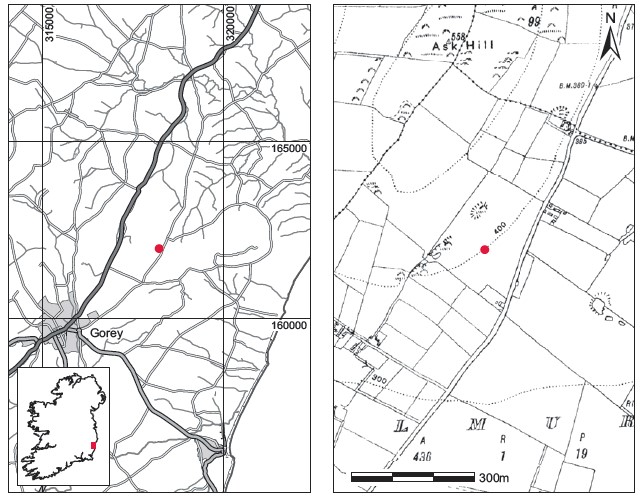
Grave 1
When examined, it was noted that the cist stones that protruded from the section had been dislodged and subsequently replaced by the finders. Two quite large spreads of charcoal were also noted at the eastern and western sides of the cist (Fig. 3.226). The chamber was polygonal in plan, formed of four principal edge-set stones (Pl. 71). It is probable that one other side stone originally existed, but this was not found in the vicinity of the cist. Internally, the cist measured 0.53m by 0.4m by c. 0.25m high. The maximum length of the side stones was 0.55m, maximum height 0.2m and maximum thickness 0.14m. The cist was flanked on the outside and above by a number of packing stones. The upper level of packing stones (on the cist walls) consisted of thin, shale-like slabs, with a maximum length of 0.2m. These were laid flat on the edges of the side stones, and also at an angle behind them. Below this was a layer of nine stones, lying directly over the principal side stones. These were also laid flat over the side stones and the maximum measurements were 0.23m by 0.15m. A number of smaller packing stones had been placed in a vertical position outside the main side stones. The cist was paved with a single polygonal slab, which measured 0.43m by 0.44m. It was set tightly against the side slabs, and its shape was so similar to the plan of the cist that it seems likely that the side stones were chosen to fit around it. No capstone was found around the cist, but
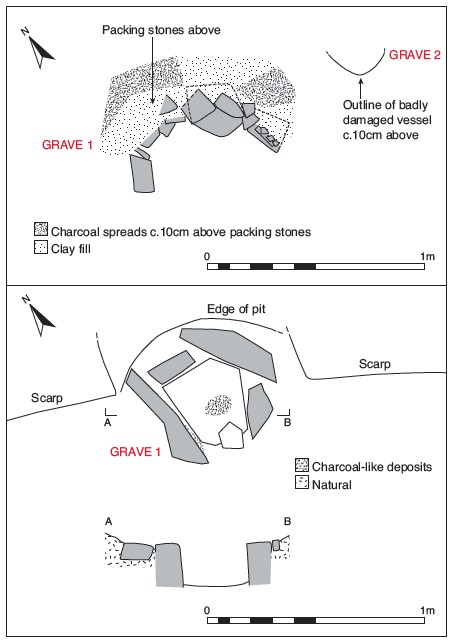
it may have been removed by the bulldozer. The pit dug to receive the cist was mostly destroyed but measured c. 0.88m across.363
The cist contained a cremation representing the remains of a child of 6–10 years of age, which were held within an upright vase urn. The main fill of the cist was a compact brownyellow clay (0.05–0.07m in depth) that lay directly over the floor slab and contained cremated bone (2001:107) at the northern and western sides, and some in situ pottery sherds at the southern edge and one at the northern (back) side. Two dark, charcoal-like deposits were noted in the cist fill, one circular in the centre (possibly where the vessel had stood), and a smaller, shallower deposit along the inner edge of the western side stone. These were retrieved and sampled.
Vase urn, 2001:106 (Pl. 72; Fig. 3.227)
The vessel has the typical profile of a vase urn—a pronounced shoulder and out-turned neck. It expands at the shoulder to its maximum diameter and then tapers sharply to the base. The rim was broken off into five pieces, the longest measuring 11cm by 6.5cm. There are three cracks in the upper body of the vessel. The ware is fine. The exterior is orange-brown in colour with few visible grits. The vessel has a slightly burnished appearance. This vase urn is decorated with horizontal bands of incised and impressed decoration. It
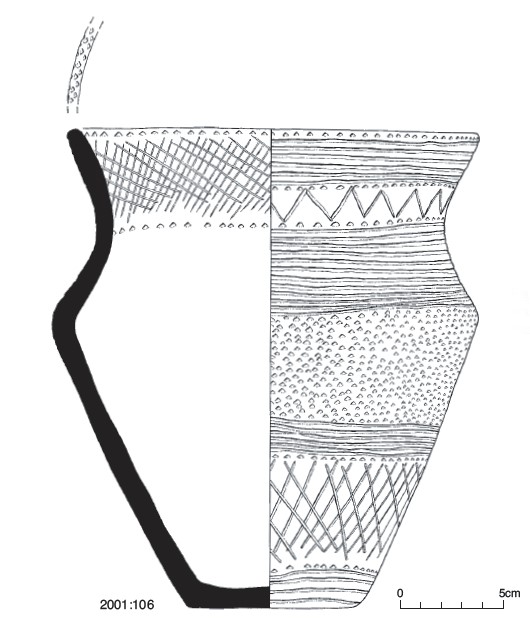
has been conserved and restored. The rim is decorated with a single band of impressed triangles. The neck, which had completely broken off the vessel, is decorated both internally and externally. The decoration on the interior of the rim consists of a single band of incised lattice decoration delimited above and below by a single row of small triangular impressions. This band is mirrored in one of the bands of external decoration. The uppermost band of external decoration on the neck consists of six incised horizontal lines. Below this is a band of single incised chevrons delimited on both sides by small triangular impressions. Below this the shoulder is decorated with a band of twelve incised horizontal lines. Underneath this is the widest band of the vessel, consisting of sixteen horizontal rows of impressed triangles. Below this is a band of six incised horizontal lines. Underneath this is a thick band of incised lattice decoration, again bordered above and below by a single row of impressed triangles. The final band of decoration consists of four incised horizontal lines.
Dimensions: existing H 19.3cm; est. H 24cm; existing D rim 17.4cm; est. D rim 19cm; D base 9.6cm; T 0.6–0.8cm.
Grave 2 (possible) (Fig. 3.226)
During excavation of the cist, the profile of a vessel was noted in the section to the east of the cist (Pl. 73). The nearest edge of the vessel was c. 0.25m east of the charcoal deposit above the eastern edge of the cist, and 0.34m from the edge of the cist. The fragmentary vessel appears to have been sliced vertically by the bulldozer, and was found in a very poor state of preservation. No human remains were found near this vessel, but it may have represented another burial.
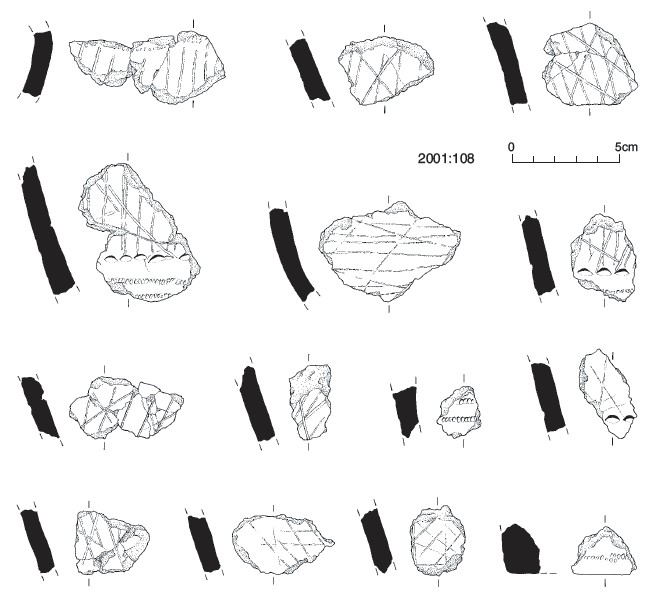
Pottery, 2001:108 (Fig. 3.228)
A number of body sherds survive, of fine, orange-coloured ware similar to the vase urn from grave 1. The decoration consists of elements of panels of straight and oblique lines, some edged with single rows of triangular impressions and some comb impressions. This vessel was also, most likely, a vase urn. It is not possible to estimate dimensions.
Comment
A sample of the cremated bone yielded a date of 3550±40 BP,364 which calibrates to 2016–1756 BC at 95.4% probability. The vase urn is placed in stage 2 of the development of the vase urn typology (Brindley 2007, 278–9), dated to c. 1930/20–c. 1830 BC. It is highly likely that there was a small flat cemetery present at this site and that part of it may have been destroyed in preparing the site for building works. It was not possible to establish whether there are burials extending beyond the area taken up by the new house and its garden.
HUMAN REMAINS
LAUREEN BUCKLEY
Sample 2001:107 consisted of over 3,000 fragments of bone with a total weight of 755g. One larger fragment was a blue/grey colour and there was some blue colour on the internal surface of a femur epiphysis, but the remainder was white, efficiently cremated bone. There was cracking and fissuring of the bone surface, with some distortion of the long bones.
Table 3.137—Fragmentation of bone, 2001:107.

The fragmentation of the sample is shown in Table 3.137, with the largest fragment being 94mm in length. It can be seen that there is an almost equal distribution of fragments among the various size ranges, with most of the sample consisting of medium to large fragments. Although the site was disturbed, the bones were inside an urn so it is unlikely that there was any post-depositional fragmentation of the bone. There is a sufficient proportion of larger fragments to indicate that the bones were not deliberately fragmented before deposition, although fragmentation would have occurred as they were being put into the vessel.
Identifiable bone
A total of 413g (55% of the total bone) was identified (Table 3.138). This is a good proportion, considering that there was not a great quantity of very large fragments present.
Table 3.138—Proportion of identified bone, 2001:107.
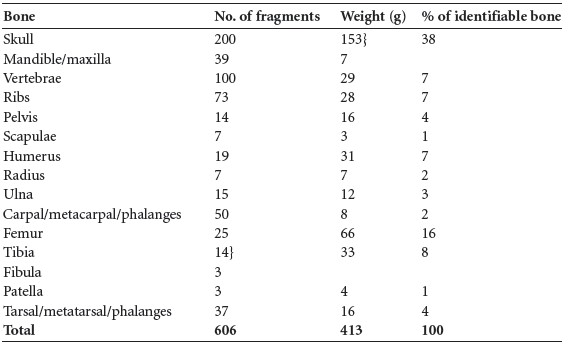
Table 3.139—Summary of identified bone, 2001:107.

Table 3.139 summarises the main parts of the skeleton identified from this sample. It can be seen that while the proportion of skull is higher than expected and the axial skeleton is almost exactly what it should be, the proportion of upper and lower limbs is lower than expected. This may be because very few of the bones of the hands and feet were collected. It seems to have been mainly the bigger bones that were collected.
Skull
Two large fragments of the squamous frontal bone were present and there were parts of two orbits. The left orbit had cribra orbitalia. There were at least two large fragments of parietal bone, one from a left bone and one from a right bone. There were two large fragments from the left and right side of the squamous occipital bone. Part of the basilar occipital with unfused symphysis was also present. Several other small fragments of frontal, parietal and occipital bone were also present. All the sutures were open. Fragments from a left and a right temporal bone were present, although only the right petrous temporal remained. Part of the left mandibular fossa and the superior part of the auditory meatus were present. The body and part of the left and right greater wings of the sphenoid survived, and there were fragments of the left and right zygomatic bones.
Mandible, maxilla, teeth
Part of a ramus and four fragments of the body of the mandible were present and there were some sockets visible. There were also fragments of maxilla with a few partial sockets.
Dentition
A permanent lower incisor root was present and there was another root, possibly of an upper incisor, with its tip not fully closed. Two other single-rooted teeth were present, in one of which the tip of the root was also not fully closed. The roots of two possible canine teeth were also present. There were roots from at least five molar teeth and two had partial crowns. One was a deciduous molar. A permanent incisor crown, 22, was almost complete and there was also a lower incisor crown. Two complete upper molar crowns that were probably unerupted were present. It is not possible to be precise about the age of this individual but, since there may have been unerupted permanent incisors, at least the first permanent molars present and the crown of the second molars formed, it is probable that the juvenile was aged 6–10 years.
Vertebrae
The dens articulation area from a first cervical vertebra, the left side of the second cervical vertebra and at least four bodies and three arches from the lower cervical vertebrae were present. The thoracic vertebrae consisted of eleven fragmentary bodies and fragments of at least four neural arches. There were also a few fragments of posterior articular surfaces from the lumbar vertebrae.
Ribs
There were several fragments of shaft, and at least six ribs from the left and six from the right side had their tubercles visible.
Pelvis
There were several fragments of ilium, including a fragment from around the sciatic notch, although the complete sciatic notch was not observable. A large fragment of ischium with unfused ischial tuberosity was present, and there was also a right pubic bone from a juvenile and the ramus of a left pubic bone. The body of the first and fragments of two other sacral vertebrae were present.
Scapula
Two acromial spines, one coracoid process and the lateral border of the left scapula were present. The right glenoid area was also present.
Humerus
The proximal third of a right humerus from a juvenile with unfused epiphysis was present. There was also the distal end of the right bone with unfused epiphysis. The distal end of the shaft of a left humerus, also with unfused epiphyses, was present, and there were left and right distal epiphyses. There were also some shaft fragments, including some from the proximal end of the left humerus.
Radius
The proximal end of the diaphysis of a radius with the metaphysis visible was present, as well as other fragments of shaft.
Ulna
This consisted of shaft fragments and the proximal end of the left ulna. There were also fragments from the distal third of a shaft and fragments of the distal end with the metaphysis visible.
Carpals, metacarpals, phalanges
The capitate, six metacarpal shafts and a few metacarpal heads, and three proximal, three middle and six distal phalanges were present.
Femur
The proximal third of a left femur from a juvenile was present; the proximal shaft, neck and proximal metaphysis were visible and both the proximal epiphysis and greater trochanter were present and unfused. The greater trochanter of a right femur was also present. The distal end of a shaft of a right femur and unfused distal epiphysis were present, as well as a fragment of a distal epiphysis from one other femur. There were also other shaft fragments present.
Tibia
The proximal third of a shaft of a left tibia with unfused proximal epiphysis was present. The proximal epiphysis of a right bone was also present and there were several fragments of shaft.
Fibula
Fragments of shaft only were present.
Patella
A right patella was almost complete.
Tarsal, metatarsals, phalanges
Fragments of a calcaneum, two tali, two cuboids, a navicular and a cuneiform were present, as well as four metatarsal shafts, including two first metatarsal, three proximal and two distal foot phalanges.
Minimum number of individuals
Since there was no duplication of skeletal elements only one individual was present. It was difficult to determine age from tooth roots, but it is likely that the individual was aged 6–12 years and probably 6–10 years.
Summary and conclusions
This sample consisted of 755g of cremated bone. Most of the bone was efficiently cremated but some parts, including the top of a femur, were less well cremated. The bone was moderately fragmented, probably as a result of being forced into an urn rather than as a deliberate part of the cremation ritual. Most parts of the skeleton were represented, although there seemed to be a bias towards the larger bones, with very few small bones of the hands and feet collected. As the remains seemed to represent one juvenile, aged 6–10 years, it is possible that the smaller bones were difficult to identify at the time of collection.
362. Parish of Kilmakilloge, barony of Gorey. SMR WX007-066——. IGR 318242 161974.
363. The cist was fully excavated and the landowner agreed to fill it with stones and clay and to cover it over.
364. GrA-24172.